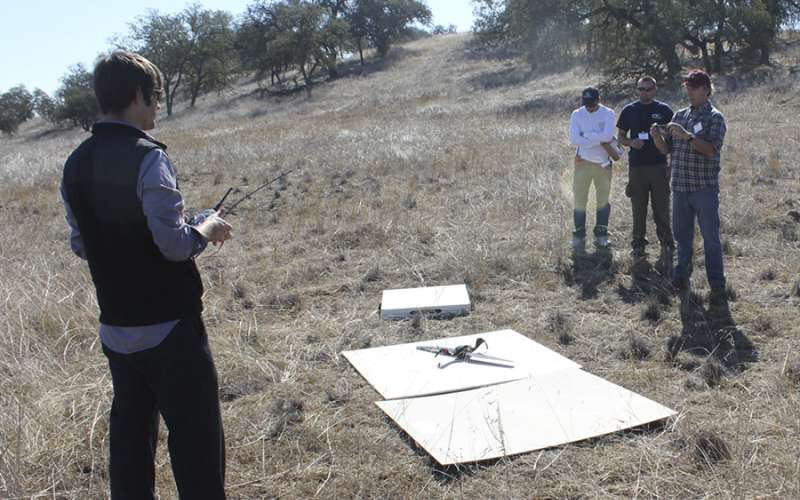Looking at nature for inspiration, an Aerospace team is developing an unmanned aerial system (UAS) that borrows flight characteristics from winged maple seeds.
The small and inexpensive UAS, dubbed AeroSeed, has a number of advantages over current UAS technology, and could be used in a variety of fields.
“The unique capabilities of this vehicle make it multi-purposed,” said Chris Dunbar, principal director of the Guidance and Control Subdivision, Vehicle Systems Division.

AeroSeed is a small UAS that spins as it flies, and takes full advantage of the wind. It can fly at high speeds, is agile, and remains stable even in less-than-ideal-weather conditions. For its size, AeroSeed can carry a large payload.
If AeroSeed loses a wing and propeller due to functional or mechanical failure, it can continue stable flight. Even with the loss of both propellers, it will simply autorotate to the ground, rather than plummet to the ground like other UASs.
It can also stay in the air for a long time, due to its ability to ride the wind rather than relying completely on battery power to stay aloft. The propulsion system can be turned off and on when needed for takeoff or repositioning to a desired altitude and waypoint.
“Substantial differences exist between the AeroSeed platform and conventional aircraft,” said Dr. Evan Ulrich, a member of the technical staff at Aerospace. “The most obvious departure from convention is the lack of a fixed heading/orientation. This configuration solves several historically difficult design and performance challenges for rotorcraft.”
Ulrich came up with an idea for a single-wing rotorcraft while studying autorotating plant seeds in graduate school at the University of Maryland. After Ulrich was hired by Aerospace, Dunbar recognized the uniqueness of this concept at about the same time Aerospace was beginning to explore applying its core expertise and skills to the UAS market. Hence, AeroSeed was born.

“The AeroSeed has roots in the autorotating plant-seed world, and as such it features bio-inspired design and functionality,” Ulrich said. “For example, the balance of mass and aerodynamic forces mimics that of an autorotating plant seed which enables AeroSeed to use this basic mode of unpowered transit.”
Potential Applications
Although the vehicle is still in development, a number of possible use cases are emerging. One potential use is for AeroSeed to collect in situ weather measurements. With the vehicle’s unique design, the flight characteristics exploit wind turbulence rather than fight it.
“AeroSeed reacts like a surfer riding a wave or a bird on a thermal, allowing the wind to propel it forward at the same time keeping it aloft,” Dunbar said. “AeroSeed thrives in turbulence.”
This suggests the possibility to assess wind gusts and turbulence prior to a rocket launch. Currently, weather balloons with instrumentation are released prior to a launch, but these have a number of limitations. Having a number of AeroSeed vehicles with the same instrumentation fly in formation and at prescribed altitudes would yield real-time, multidimensional winds-aloft situational awareness.
Other possibilities include using AeroSeed to collect information on forest fires, tornadoes, and thunderstorms. Because the vehicle is small and inexpensive, it would be possible to fly large numbers of them to gather data over large geographic areas.
Development and Testing
With these and other potential uses, the team has been motivated to keep pushing forward. AeroSeed has undergone many iterations in less than a year.
The team is focused on quick and agile “design, build, fly” development, constantly changing things, testing, and then making more changes. Many components are printed on 3-D printers at Aerospace, which helps to accelerate the design pace.
Due to Federal Aviation Administration (FAA) regulations, the team has had trouble finding a place to fly their vehicle, but they haven’t let that slow them down. Always innovating, the team can be seen flying AeroSeed after hours on Aerospace’s campus in a repurposed shipping and delivery tunnel augmented with netting over the driveway to allow for GPS signal access.
Twice this year, the team went to a Joint Interagency Field Experiment (JIFX) hosted by the Naval Postgraduate School in Paso Robles, CA. According to Ulrich, “The quarterly JIFX event allows researchers to conduct experiments in airspace outside the jurisdiction of the FAA.”
At their first JIFX in August, they collected valuable flight data—along with an award for the most spectacular experimental failure, which just shows the team’s dedication to pushing their vehicle and determining its limits. The failure occurred when AeroSeed was flying at its top speed and one of the components melted, causing the motor to fall off.
At the next JIFX in November, the researchers tried out two new versions of the redesigned AeroSeed, one with advanced avionics for cyclic control and the other to collect wind-shear data.
“We successfully flew both variants and successfully demonstrated cyclic control (a first for an aircraft of this design),” Ulrich said. “The wind-shear data-collection variant flew successfully to 750 feet altitude and collected and telemetered data that will be used to determine local wind shear.”
Back at Aerospace, they continue to test, improve, and explore potential applications. More test flights will no doubt be in order, and more improvements will be made. The possible uses for this technology make it one to watch.
Video of AeroSeed in Flight:

